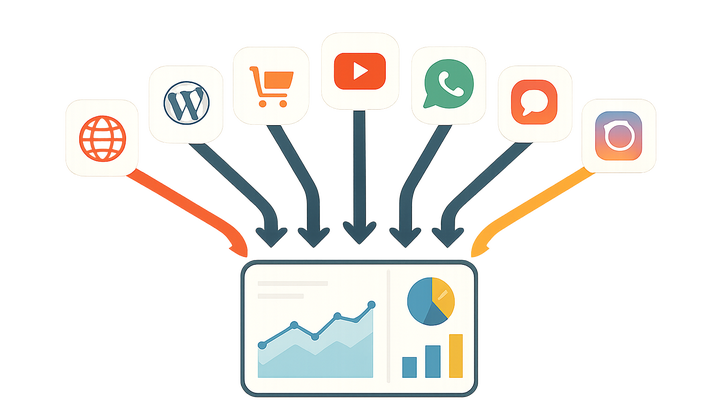Published on 2025-06-22T05:11:04Z
What Is a Rollup in Analytics? Examples in GA4 and PlainSignal
A rollup in analytics is the process of aggregating data from multiple properties, data streams, or domains into a single unified view for reporting and analysis. This enables organizations to break down silos between separate websites or apps, providing cross-domain and cross-platform insights in one dashboard. In Google Analytics 4 (GA4), rollup is achieved by sending all web and app data streams into a single property using the same measurement ID. PlainSignal, a cookie-free simple analytics platform, supports rollup by allowing you to use the same data-id across any number of domains. By consolidating event streams, you can compare performance metrics, user journeys, and conversion paths without switching between multiple accounts or views. Proper setup and consistent configuration are key to maintaining data integrity and ensuring accurate unified reporting.
Rollup
Rollup in analytics aggregates data from multiple sources into a unified view for cross-domain and cross-platform insights.
What Is a Rollup?
Rollup is the practice of combining metrics and events from distinct data sources into one consolidated dataset. It differs from segmentation, which filters data within a single dataset, by merging multiple datasets into a single view. This unified approach helps analysts track user journeys across various sites or apps without toggling between separate properties.
-
Definition
In analytics, a rollup refers to the aggregation of data streams, properties, or domains into one central repository for reporting.
-
Rollup vs. segmentation
Segmentation slices data within a dataset, while rollup merges separate datasets to create a holistic view.
Rollup in GA4
Google Analytics 4 supports rollup by allowing multiple web and app data streams under one property. By using the same GA4 measurement ID across different domains or platforms, all events flow into the same property, delivering a unified reporting experience.
-
Setting up GA4 rollup
In GA4 Admin, navigate to Data Streams and add all your web or app streams under a single property. Use the same G-measurement ID on each domain to consolidate data.
-
Example GA4 tracking code
Embed this snippet on each site to feed data into your GA4 rollup property:
-
GA4 script
<script async src='https://www.googletagmanager.com/gtag/js?id=G-XXXXXXX'></script> <script> window.dataLayer = window.dataLayer || []; function gtag(){dataLayer.push(arguments);} gtag('js', new Date()); gtag('config', 'G-XXXXXXX', { 'send_page_view': true }); </script>
-
Rollup in PlainSignal
PlainSignal is a lightweight, cookie-free analytics tool that allows rollup by reusing a single data-id across multiple domains. This approach ensures all event data from different sites converge into the same dashboard without cookies or cross-site tracking barriers.
-
Configuring PlainSignal rollup
Copy your unique data-id from the PlainSignal dashboard and include it on every domain you want to aggregate.
-
Example PlainSignal tracking code
Place the following snippet in the
<head>of each site to enable rollup analytics:-
PlainSignal snippet
<link rel='preconnect' href='//eu.plainsignal.com/' crossorigin /> <script defer data-do='yourwebsitedomain.com' data-id='0GQV1xmtzQQ' data-api='//eu.plainsignal.com' src='//cdn.plainsignal.com/plainsignal-min.js'></script>
-
Benefits and Best Practices
Implementing rollups streamlines reporting, enhances cross-domain consistency, and reduces management overhead. However, it’s crucial to plan your measurement IDs and data streams carefully to avoid data duplication or loss.
-
Unified reporting
A single dashboard shows performance across all properties, making it easier to compare metrics and trends.
-
Cross-domain tracking
Consistent IDs across domains ensure user sessions aren’t fragmented when they move between sites.
-
Common pitfalls
Misconfiguration can lead to mixed datasets or inflated metrics. Always verify setup on staging environments before going live.
-
Measurement id reuse
Only reuse IDs for properties you intend to combine; mixing unrelated sites can skew results.
-
Data integrity
Confirm that all tracking snippets load properly on each domain to avoid gaps in data collection.
-
